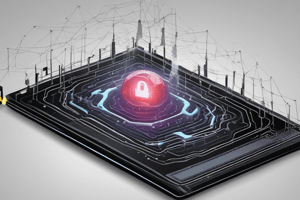Podcast
Questions and Answers
What type of attack involves creating a fake identity or scenario to elicit urgent responses?
What type of attack involves creating a fake identity or scenario to elicit urgent responses?
- Pretexting (correct)
- Vishing
- Phishing
- Spear Phishing
What is the primary risk associated with foreign-sourced attacks?
What is the primary risk associated with foreign-sourced attacks?
- Physical threats to devices
- Malware on personal computers
- Loss of encryption
- Surveillance using products sold by governments (correct)
Which phase of a cyberattack involves gaining higher-level access?
Which phase of a cyberattack involves gaining higher-level access?
- Covering Tracks
- Gaining Access
- Reconnaissance
- Escalation of Privileges (correct)
Which attack involves the use of telephony systems with spoofed caller IDs?
Which attack involves the use of telephony systems with spoofed caller IDs?
What is a primary concern with cloud computing in terms of data security?
What is a primary concern with cloud computing in terms of data security?
Which of the following best describes 'watering hole attacks'?
Which of the following best describes 'watering hole attacks'?
Which of these is a methodology used for threat modeling that includes risk analysis?
Which of these is a methodology used for threat modeling that includes risk analysis?
What is the impact of improperly managed Internet of Things (IoT) devices?
What is the impact of improperly managed Internet of Things (IoT) devices?
Which of the following refers to an attack that entails reworking network devices without authorization?
Which of the following refers to an attack that entails reworking network devices without authorization?
What is an example of social engineering that involves manipulating trust through electronic communications?
What is an example of social engineering that involves manipulating trust through electronic communications?
What technique does an attacker use in a denial of service attack?
What technique does an attacker use in a denial of service attack?
Which type of attack uses an intermediary to intercept communications?
Which type of attack uses an intermediary to intercept communications?
What is the primary goal of an SQL injection attack?
What is the primary goal of an SQL injection attack?
Which of the following is NOT a characteristic of social engineering attacks?
Which of the following is NOT a characteristic of social engineering attacks?
In a reverse shell attack, what is the attacker's primary strategy?
In a reverse shell attack, what is the attacker's primary strategy?
What type of malware is characterized by mutating to avoid detection?
What type of malware is characterized by mutating to avoid detection?
Which attack method involves taking advantage of a system performing operations out of order?
Which attack method involves taking advantage of a system performing operations out of order?
What is an example of a network-based attack?
What is an example of a network-based attack?
What is spoofing primarily concerned with?
What is spoofing primarily concerned with?
Which of the following is a common internal threat agent?
Which of the following is a common internal threat agent?
Flashcards
Network-Based Attacks
Network-Based Attacks
A type of attack that uses the infrastructure of a network to disrupt operations.
Covert Channels
Covert Channels
A covert channel uses data transmission methods that were not originally intended for such, often disguised to appear as legitimate network traffic.
Buffer Overflows
Buffer Overflows
An overflow in a program's buffer, where the attacker inputs more data than intended, leading to potential code injection.
Denial of Service (DoS)
Denial of Service (DoS)
Signup and view all the flashcards
Replay Attacks
Replay Attacks
Signup and view all the flashcards
Port Scanning
Port Scanning
Signup and view all the flashcards
Reverse Shell Attacks
Reverse Shell Attacks
Signup and view all the flashcards
Return-Oriented Attacks
Return-Oriented Attacks
Signup and view all the flashcards
Spoofing
Spoofing
Signup and view all the flashcards
SQL Injection
SQL Injection
Signup and view all the flashcards
Rogue Mobile App
Rogue Mobile App
Signup and view all the flashcards
Phishing
Phishing
Signup and view all the flashcards
Spear Phishing
Spear Phishing
Signup and view all the flashcards
Piggybacking
Piggybacking
Signup and view all the flashcards
Tampering
Tampering
Signup and view all the flashcards
Embedded Software Code
Embedded Software Code
Signup and view all the flashcards
Pharming
Pharming
Signup and view all the flashcards
Reconnaissance
Reconnaissance
Signup and view all the flashcards
PASTA
PASTA
Signup and view all the flashcards
VAST
VAST
Signup and view all the flashcards
Study Notes
Cybersecurity Threats and Attacks
- Cybersecurity protects an organization's IT infrastructure and data from malicious actors through technology, internal controls, and best practices.
Threat Agents
- Attacker/Hacker: Individuals seeking unauthorized access.
- Adversary: Motivated to attack due to conflict or incentive.
- Government/State-Sponsored: Funded by nation-states.
- Hacktivist: Driven by social or political causes.
- Insider: Someone with authorized access to systems.
- External Threats: Attacks originating outside the organization.
Cyberattack Types
- Network-Based Attacks: Exploit network infrastructure.
- Backdoors/Trapdoors: Secret access points.
- Covert Channels: Non-intended data transmission methods.
- Buffer Overflows: Injecting malicious code by exceeding buffer capacity.
- Denial-of-Service (DoS): Overwhelm a system with traffic.
- Distributed Denial-of-Service (DDoS): DoS attacks from multiple sources.
- Man-in-the-Middle (MITM): Attacker intercepts communication.
- Replay Attacks: Attacker replays intercepted communications.
- Port Scanning: Identify open ports.
- Reverse Shell Attacks: Bypass firewalls.
- Return-Oriented Attacks: Combine legitimate code sequences.
- Spoofing: Impersonation (e.g., IP, MAC, DNS, hyperlink).
- Application-Based Attacks: Target application vulnerabilities.
- SQL Injection: Inject malicious SQL code into applications.
- Cross-Site Scripting (XSS): Inject malicious scripts into websites.
- Race Condition: Exploit timing vulnerabilities.
- Mobile Code (Malicious): Self-replicating from computer to computer.
- Host-Based Attacks: Target a single host.
- Brute-Force Attacks: Systematically try passwords.
- Keystroke Logging: Record keystrokes.
- Malware: Unauthorized software (viruses, worms, Trojans, adware, spyware).
- Rogue Mobile Apps: Malicious applications disguised as legitimate ones.
- Social Engineering Attacks: Exploit human psychology.
- Phishing: Deceptive emails/messages.
- Spear Phishing: Targeted phishing attacks.
- Business Email Compromise (BEC): Targets executives.
- Pretexting: Create a fake scenario.
- Vishing: Phishing over the phone.
- Physical (On-Premises) Attacks: Exploit physical access.
- Piggybacking: Following someone into a restricted area.
- Tampering: Physically altering equipment.
- Theft: Unauthorized removal of assets.
- Supply Chain Attacks: Exploit vulnerabilities in the supply chain.
- Embedded Software Code: Malicious software within hardware/software.
- Foreign-Sourced Attacks: Malicious code disguised as legitimate products.
- Watering Hole Attacks: Target websites used by multiple organizations.
Cyberattack Stages
- Reconnaissance: Gathering information.
- Gaining Access: Entering the target system.
- Privilege Escalation: Increasing access level.
- Maintaining Access: Staying in the system.
- Network Exploitation and Exfiltration: Malicious activity.
- Covering Tracks: Hiding the attack.
Risks in Different Technologies
- Cloud Computing: Additional exposure, malware, compliance violations, data/control loss, visibility loss, multi-cloud management, intellectual property theft.
- Mobile Technologies: Malware, lack of updates/encryption, physical threats, unsecured Wi-Fi, location tracking.
- Internet of Things (IoT): Device mismanagement, spoofing, escalated cyberattacks, expanded footprint, information theft, outdated firmware, malware, network attacks.
Threat Modeling Methodologies
- PASTA (Process for Attack Simulation and Threat Analysis): Define objectives, scope, decomposition, threat/vulnerability analysis, attack modeling/simulation, and risk analysis.
- VAST (Visual, Agile, and Simple Threat): Flexible model for scaling threat analysis.
- STRIDE (Spoofing, Tampering, Repudiation, Information Disclosure, Denial-of-Service, Elevation of Privilege): Categorizes various threats.
Studying That Suits You
Use AI to generate personalized quizzes and flashcards to suit your learning preferences.




